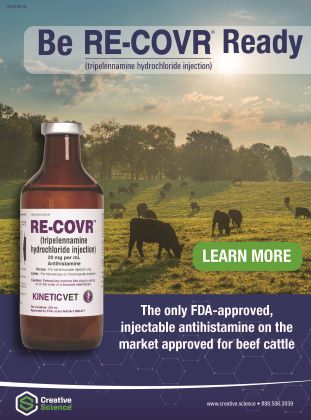The Latest in Dairy Sustainability Research and Technology

The Latest in Dairy Sustainability Research and Technology
By Jaclyn Krymowski
The sustainability movement is now engrained in every aspect of American agriculture. In particular, the collective dairy industry has led the charge, setting a goal to achieve greenhouse gas neutrality by 2050. With this, it’s unsurprising that more and more sustainability products, systems and research are being introduced to the dairy supply chain, including the farm itself.
To reach a goal, one needs to determine where they are now, figure out what efforts will lead to positive change, adopt the practice, and then measure results.
For success, sustainability changes need to be feasible both financially and physically. One needs to push the pencil and do the legwork to ensure the practice is practical and worth the effort. While most practices that increase productivity also improve sustainability, that is not always the case.
Today, the dairy industry is saturated with products and practices dairy producers can use to improve sustainability. Private companies, universities and organizations are all working to develop tools that are truly affordable and effective. As a farmer, it can be extremely overwhelming to know how and if.
According to a 2023 report Birth of dairy 4.0, “Growing literature shows that the adoption of technologies of the fourth industrial revolution (named Industry 4.0) has promising potential to bring about breakthroughs and new insights and unlock advancement opportunities in many areas of the food manufacturing sector.”
Finding Your Numbers
The first step is to assess where you are. (It may sound counterintuitive, but you need to know this before deciding where to go.) There is a wealth of different options for this, from free to paid resources. Some big ones include:
• FARM Environmental Stewardship
• Professional Dairy Producers
• Penn State
FARM-ES has a wealth of information about sustainability on its website. Funded by the national check-off, it is your dairy checkoff dollars at work.
These resources can be used to pair with the on-farm data you may already have depending on what herd management and/or monitoring software you already have.
In some cases, you may also be motivated in what regulatory discussions, concerns or incentives are coming down that may impact your dairy and how you do business. For these types of events, it likely be worth the effort to include your consultant, extension agent and perhaps experts from your local land grant university or Farm Bureau to evaluate metrics and keep your Is dotted and Ts crossed.
Manure Management
The way manure is managed and stored makes a tremendous impact on sustainability. This is an area that is continually supported by academics, government aid and the private sector to become easier and more effective for farms.
For example, a 2023 Illinois Farm Bureau funded study at Southern Illinois University looked at the effects of two manure application methods on crop performance and soil health.
It found that switching from nitrogen-based to phosphorus-based manure rates for field application keeps soil phosphorus levels manageable. This approach provides essential nutrients without excessive phosphorus buildup, although additional nitrogen supplementation is necessary for optimal yield.
The study also highlighted the superiority of injection over broadcast application. Injection eliminates the need for immediate incorporation, preventing ammonia volatilization and reducing nutrient runoff. This method likewise supports no-till and cover crop systems, preserving soil health and minimizing nutrient pollution.
It would be remiss to discuss manure management and sustainability without giving a nod to new handling and storage methods. Methane digesters are becoming more commonplace on dairies and touted for not only reducing emissions but also providing on-farm alternative fuel and energy.
To give some perspective, data shows nearly 80% of digesters on farms in the U.S. are dairies. According to one report, in 2022 manure digesters reduced a total of 10.43 million metric tons of CO2 equivalent with a 9.47 equivalent being methane reduction specifically. More funding and programs are being made available to support farms implementing such technology, so if this has been something you’ve considered it’s looking into resources that your state may offer.
Feed and Additives
Sustainability-focused additives for rations are very hot in the nutrition space. Most of these are made to focus on reducing methane emissions, but it could also encompass products that enhance feed efficiency or reduce the need for veterinary treatments.
“With fewer farms on the landscape and more cows per farm, the beef and dairy industries recognize the dual importance of feed quality on feed efficiency and methane production. One of the strategies that have been increasingly explored is the use of feed additives to reduce enteric methane emissions,” writes University of Wisconsin extension educator Alison P. Pfau in the bulletin Feed additives, an alternative to mitigate greenhouse gas emissions in dairy cattle.
A great example of such an additive is Elanco’s Bovaer® (3-NOP) which is “a first-in-class methane-reducing product for beef and dairy cattle.”
The company boasts that the additive has gone under over 50 peer-reviewed studies plus 48 on-farm trials across 14 countries. Consistently, Bovaer® “consistently reduces enteric methane emissions by approximately 30% for dairy cows and even higher percentages for beef cattle”
Robotics and Cattle Monitoring Technology
There’s a plethora of tools available to help enhance your herd’s carbon footprint by mode of day-to-day management. One of the biggest that comes to mind if, of course, robotics milkers. Increase in milking frequency alone is a big reason why robotics allow for greater sustainability by way of more milk per cow. These are undoubtedly the greatest success story of useful, practical robotics in the industry if not in all of agriculture.
But robots may soon be displaced for the hottest dairy tech in the near future. Monitoring systems – from cameras to rumen boluses to monitors powered by artificial intelligence – may be the next big thing that transforms how we dairy with sustainability in mind.
For example, Italian-based Cynomys Agritech is a company that uses modular devices that monitor air, water, equipment energy and even greenhouses gases on farms in real time.
Don’t Forget Farming Methods
It’s easy to get lost in the weeds of management and buying the “next thing” in the pursuit of greater sustainability and more efficient dairying. However, farming practices, especially when it comes to agronomy and equipment usage, are foundational to good stewardship.This includes considering till vs. no-till, proper nutrient management and judicious usage of power and energy.




